
Importance of Hand and Wrist Function
In any single day, the hand and wrist perform immeasurable tasks, actions, gestures, and motions. A small dysfunction or injury to the hands and wrists can cause a disproportionate amount of inconvenience in accomplishing even the simplest of daily activities.
Communication
Sign language is an extreme example of how much communication is accomplished through hand and wrist gestures. A friendly wave, a gentle caress, a sharp flick, or a tight squeeze are just some examples of the many ways the hand and wrist help us communicate with one another.
Sensation
The hand holds a higher concentration of nerve fibres than other parts of the body. This allows us to feel our way through the world. The hand feels whether something is soft or hard, dull or sharp, hot or cold, smooth or rough. The high concentration of nerve fibres in the hands helps us to determine safety from danger.
Activities of Daily Living
Comparable to high-performance machines, the hand and wrist perform actions that are highly precise and powerful yet extremely delicate at the same time. From driving a car, preparing a meal, to brushing our teeth, the innumerable tasks our hands accomplish throughout the day are invaluable to our quality of life.
Work, Rest, and Play
Not only are the hand and wrist incredible, articulating, powerful tools on their own, but they also enable the use of tools, machines, and instruments. The hand and wrist actions and motions of holding, pulling, pushing, grasping, twisting, squeezing, and pinching helps us carry objects and use tools like hammers and axes. They also enable fine motor skills to perform delicate tasks such as threading a needle, playing the piano, or flying a helicopter. The hand and wrist actions allow us to knit a sweater, dribble a basketball, or hold on to a favourite person.
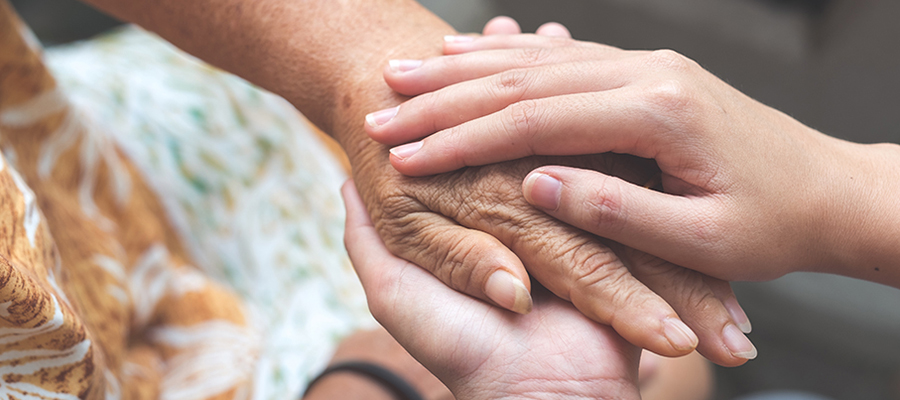
Intricate Finger, Hand, and Wrist Anatomy
Bones and Joints
Of the 206 bones in the adult body, a remarkable 27 of them are in each hand. This directly relates to the 27 joints in each hand which enables the precision and wide range of movements the hand and wrist are capable of. Cartilage and joint capsules surround, protect, and lubricate each of these articulations, creating smooth, comfortable movement.
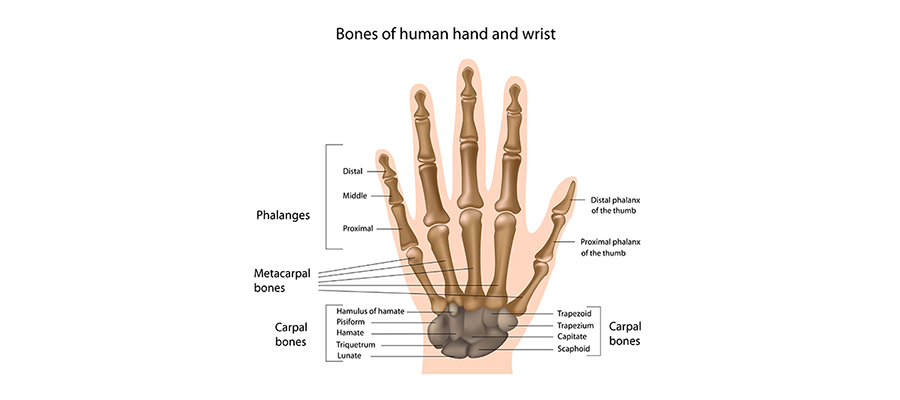
Ligaments
Strong bands of connective tissue make up the many ligaments in the fingers, hand, and wrist. They play an important role supporting each joint in the fingers, thumb, hand, and wrist. Ligaments provide stability while preventing sideways or backward movements.
Muscles and Tendons
There are 34 muscles that act on the hand providing movement, powerful pinch and grip strength, as well as fine motor function. Muscles are attached to the bones of the hand by strong bands of connective tissue. These are known as tendons. They allow the muscles to move the bones.
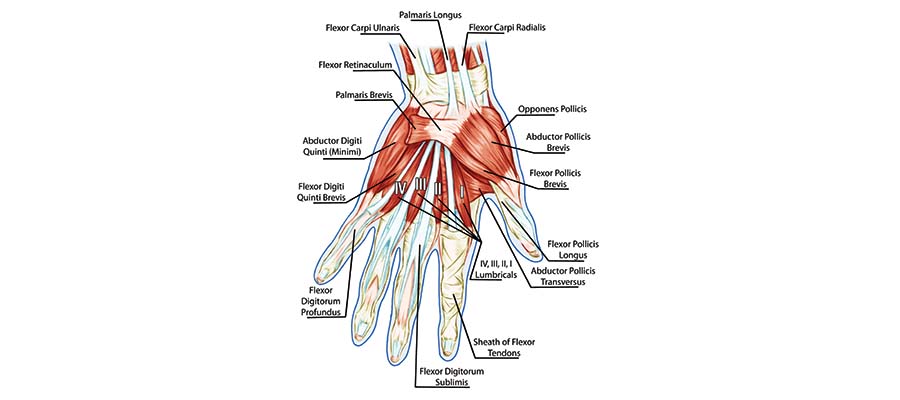
Blood Vessels
The complex web of blood vessels throughout the hand begins with two major blood vessels, the radial and ulnar arteries. As they supply blood from the forearm to the hand they branch, becoming smaller and smaller. These vessels can be less than a millimetre wide. A hand surgeon is able to repair these tiny vessels using sutures finer than the thickness of a hair.
Nerves
The ulnar nerve, radial nerve, and median nerve are the three main nerves of the hand. Nerves are the communication system of the body. Electrical signals from the hand denoting the sense of touch, temperature, and pain, is relayed to the brain through nerves. The brain sends messages through the nerves telling the muscles of the forearm and hand how and when to move.
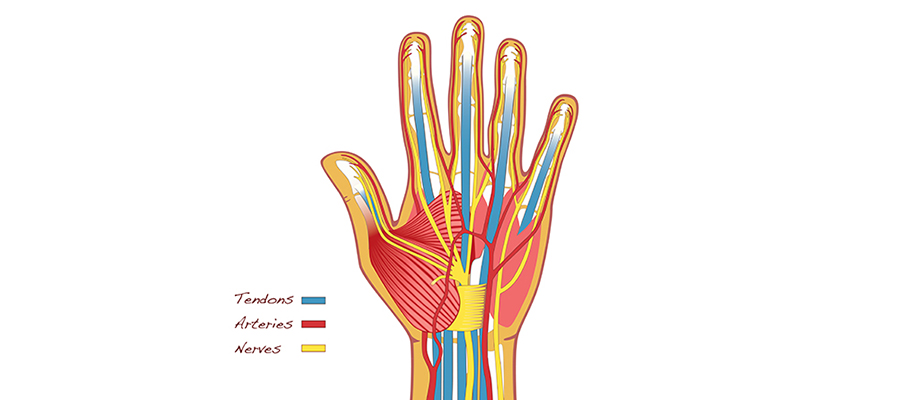
Skin and Nails
The built-in protection suit of the hand’s intricate and complex structures, the skin and nails protect against injury. Skin and nails also provide a barrier to prevent germs and infection from entering the delicate structures of the hand.
Intricate Hand Anatomy Equals Problems Unique to Hands and Wrists

Just like any incredibly well-made tool or machine, the magnitude of usefulness of the fingers, hands, and wrist effectively endangers themselves to overuse. The importance of hand function in everyday tasks, as well as highly skilled tasks, leads to injuries, repetitive wear, and age-related degradation.
Disorders of the hands may be related to deformities or birth defects. In addition, injuries such as fractures and dislocations may be painful as well as disabling. Hand dysfunction may happen overtime related to repetitive strain or overuse causing issues related to arthritis conditions, disorders of nerves or blood vessels, or problems of tendons, ligaments, joints, bones, and muscles. Even the skin and nails of the hands are unique as this skin comes into contact with the rest of the world more than any other skin of the body.
Due to the delicate and complex nature of the anatomy of fingers, thumb, hand, and wrist, diagnosis and treatment of hand problems are specialised and unique. Carpal tunnel syndrome, sports injuries of finger joints, basal thumb arthritis, amputation, bone fractures, upper-limb arthritis, and small-joint replacement are just a sample of the many disorders unique to hands and wrists.
Specialised Anatomy, Specialised Surgical Procedures
A hand surgeon specialises in detailed anatomical knowledge of the hand which gives them the unique ability to handle the fine, delicate structures with finesse and accuracy. The hand surgeon is able to proficiently explore, separate, clean, repair, and reconstruct the tiny vessels, thin bones,
Specialised Diagnostic Techniques
Not surprisingly, hand specialists have a myriad of tools and knowledge at their fingertips to aid in the diagnosis of hand impairments. Beginning with a thorough history and physical examination of the hand allows the hand specialist to inspect the nails, skin, and any mechanical dysfunction of the hand. The doctor will also be interested in the patient’s work history related to the hand as well as recent or previous injuries to the hands and wrists.
The hand specialist may follow the physical exam with diagnostic hand manoeuvres or tests such as MRI, CT scan, fluoroscopy, arthrography, ultrasound, or X-ray to confirm the diagnosis or to determine the extent of the issue. In some cases, exploratory surgery may be required of the hand surgeon to provide the definitive diagnosis and treatment plan.
Specialised Surgical Tools
A hand surgeon uses superfine surgical tools to perform when operating on fingers, thumb, hand, and wrist. Hand surgeons may routinely wear specialised glasses called loupes to magnify the complex anatomy of the hand and wrist. The incredibly fine structures of the hand such as digital nerves, arteries, and veins require even higher magnification, thus hand surgeons are often seen repairing the millimetre wide vessels using an operating microscope when making the exceptionally tiny sutures by hand.
Specialised Types of Hand Surgery
A specialist in hand surgery handles both surgical and nonsurgical treatments of hand ailments, conditions, problems, injuries, and infections as well as preventative measures and rehabilitation.
Hand surgery may include surgical cleaning, drainage, and debridement. Hand microsurgery such as skin grafts, skin flaps, fasciotomy, and reconstructive surgery are also performed by specialised hand surgeons. Injuries such as fractures or broken hand bones may require open or closed reduction and fixation surgical intervention. All types of joint replacement are implemented through hand specialist surgeons. Hand microsurgeons also perform tendon, nerve, and blood vessel repairs as well as replantation surgery in the event of an amputation.
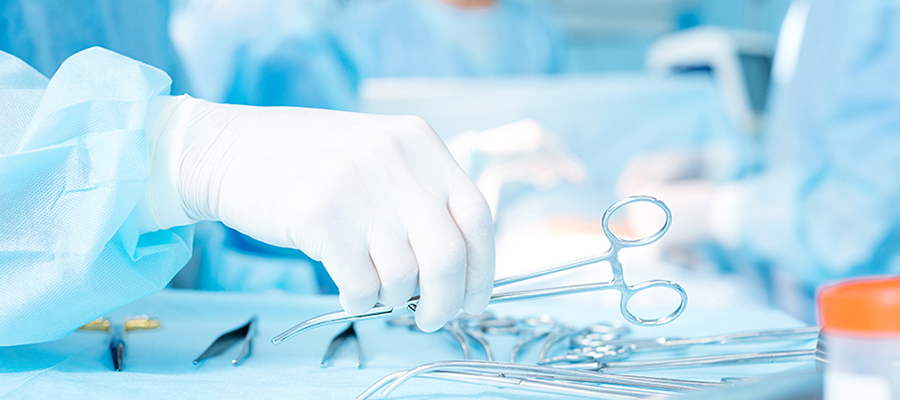
Singapore’s Specialists in Hand Surgery
In Singapore, Hand Surgery is a separate speciality on its own. It is neither a subspecialty of Plastic Surgery nor Orthopaedic Surgery. A hand surgeon in Singapore is a specialist doctor who has undergone a gruelling 6-year post-graduate training programme. The programme is dedicated to surgery of the hand and wrist, hand microsurgery of related nerves, blood vessels, and tissue transfers, as well as treatment and reconstruction of congenital hand deformities. To qualify as a Specialist Hand Surgeon, the candidate doctor must pass a rigorous examination through the Specialist Accreditation Board and then be entered into the Register of Specialists in Hand Surgery.
A hand surgeon trained in Singapore has clocked beyond 10,000 hours in the delicate art of hand surgery. A fellowship position at the Department of Hand & Reconstructive Microsurgery at Singapore’s National University Hospital is coveted by aspiring hand surgeons from around the world. Singapore’s Hand Surgeons are thus the authority on treating conditions of the hand and wrist.
How Do I Know If My Doctor is a Hand Surgeon or Not?
The full list of certified hand surgeons in Singapore can be found here:
http://www.sshs.sg/ordinary-members.html
When To Request a Referral to a Hand Surgeon
- You have a condition in the fingers, hands, and wrists which have not improved with simple measures or initial treatment by your GP.
- To treat your hand or wrist condition, a referral has been made to a doctor who does not specialise in hand and wrist problems.
- You have an unresolved hand or wrist condition despite treatment, and you would like to seek treatment from a trained and certified Hand Surgeon.
- Your current specialist doctor advises surgery for your hand or wrist condition, and you would like to seek a second opinion from a Hand Surgeon.
- You are unclear about your diagnosis and treatment plan, and you would like to seek a more detailed assessment from a Hand Surgeon for your hand or wrist condition.
Specialised Hand and Wrist Care At CHARMS
Since its establishment on April 30, 2004, The Centre for Hand and Reconstructive Microsurgery (CHARMS) is dedicated to their mission of providing caring, efficient, seamless, and personalized hand and reconstructive microsurgery services with excellent clinical outcomes.
The first of its kind, CHARMS continues to be the centre of excellence with their team of highly specialised Hand Surgeons who guide a dedicated team of Hand Occupational Therapists, Hand Physiotherapists, Splint Fabrication Specialists, and Nurses who make every effort to provide the highest level of service and care.
Meeting the demand for outstanding clinical outcomes for each patient, clinical services performed at CHARMS include all types of finger, thumb, hand, wrist, and upper limb surgery, diagnosis and treatment options, hand rehabilitation, and ongoing care. The CHARMS Hand Care Team is dedicated to easing your hand pain, discomfort, and limited function so you can get back to enjoying all your hands do for you. Speak to the caring hand specialists at CHARMS at +65 6733 9093. Or book an appointment for a consultation, diagnosis, and treatment plan options.